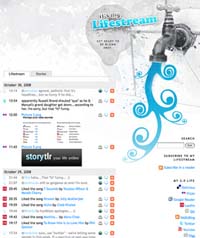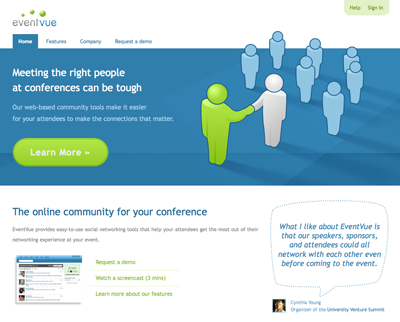Verifiable (shut down August 1, 2010)
 Stuart Roseman shut down Verifiable, a crowdsourced charting and data analysis site, to start SaneBox, a product that automatically identifies important email and separates them in a user’s inbox. Below, he explains how he knew when it was time to pull the plug on Verifiable.
Stuart Roseman shut down Verifiable, a crowdsourced charting and data analysis site, to start SaneBox, a product that automatically identifies important email and separates them in a user’s inbox. Below, he explains how he knew when it was time to pull the plug on Verifiable.
“We couldn’t charge for it. It was pretty clear. I’ve done this for a long time. I said, ‘This is a bad idea. I need a new idea.’
“The Verifiable problem still exists. It hasn’t been solved. There’s still chart junk. It’s got to be easier. But Verifiable was something I thought the world needed. SaneBox was something the world was asking for.
“My new mantra is: ‘I will make a product that people want to pay for and that they will be happy to pay for.’ I wake up in the morning and I say that. And I go to sleep at night and say that. It really changes everything.”
Related: “Out with the old business, in with the new”
Wesabe (shut down June 30, 2010)
Wesabe launched as a site to help people manage their personal finances. While competitor Mint was acquired by Intuit, Wesabe eventually shut down. In “Why Wesabe Lost to Mint,” Marc Hedlund dissects what happened.
“Mint focused on making the user do almost no work at all, by automatically editing and categorizing their data, reducing the number of fields in their signup form, and giving them immediate gratification as soon as they possibly could; we completely sucked at all of that…I was focused on trying to make the usability of editing data as easy and functional as it could be; Mint was focused on making it so you never had to do that at all. Their approach completely kicked our approach’s ass.
“You’ll hear a lot about why company A won and company B lost in any market, and in my experience, a lot of the theories thrown about — even or especially by the participants — are utter crap. A domain name doesn’t win you a market; launching second or fifth or tenth doesn’t lose you a market. You can’t blame your competitors or your board or the lack of or excess of investment. Focus on what really matters: making users happy with your product as quickly as you can, and helping them as much as you can after that. If you do those better than anyone else out there you’ll win.”
Related: “Wesabe is discontinuing its Accounts tab as of July 31st”
Storytlr (shut down February 24, 2009)
Storytlr let members create their own lifestreaming service (i.e. connecting Twitter, Flickr, Last.fm, and other accounts) at their own URL. Founder Laurent Eschenauer on what happened:
 “Storytlr started as a personal project to power my own site. People liked it, so we decided to build a nice UI and start hosting it for others. We were developing and operating the service next to our day job and families. We were quickly successfull, reaching beyond 10,000 users quickly and this meant a lot of strains on our lives (maintenance, support, etc.) and budget (~500$ monthly hosting bill) without any revenues.
“Storytlr started as a personal project to power my own site. People liked it, so we decided to build a nice UI and start hosting it for others. We were developing and operating the service next to our day job and families. We were quickly successfull, reaching beyond 10,000 users quickly and this meant a lot of strains on our lives (maintenance, support, etc.) and budget (~500$ monthly hosting bill) without any revenues.
“At that point, we started researching potential revenue models and investors, but quickly realized that the service was not well suited for a strong revenue stream. It was a tough choice, but, for the security of our families, we decided to pull the plug.”
Related: Laurent Eschenauer pitches Storytlr to Google’s Sergey Brin
TwitApps (shut down September 13, 2009)
Stuart Dallas created TwitApps as a technical exercise for himself. But after some early blog coverage, it attracted 4000 active users (and that number was growing). Despite that base, he couldn’t turn it into a product that was worth the effort.
“I considered the whole thing to be a toy project for a long time and it took me a while to realize that people were starting to rely on the service.
“Once you’ve established a free service and that service has other free competition, it’s very difficult to monetize it. It’s also very hard to change people’s impression of what something is once they’ve decided for themselves.”
“It became difficult to juggle the time demands of supporting TwitApps with the requirements of a full time job, several contracts and the need for downtime. In the end something had to go and it was clearly going to be the bit that wasn’t earning any money.”
Related: “TwitApps shutting down”
Vox (shut down September 20, 2010)
Vox was Six Apart’s friends and family blogging service. According to Michael Sippey, the company felt emphasizing TypePad was a smarter business move.
“It’s a question of focus. We’re focused on TypePad and supporting bloggers and publishers with advertising products. And that is a much more scalable proposition.
“It’s a different type of business than the friends and family blogging service that Vox provided. And it’s not that Vox wasn’t a great service or didn’t provide great utility to people. It’s that for us, from a strategy perspective, we needed to focus.”

Swivel (shut down summer of 2010)
Brian Mulloy was CEO of Swivel, a site where people shared reports of charts and numbers. The site had thousands of registered users, but less than ten paying customers. In “The Rise and Fall of Swivel.com,” he discusses how hard it is to make a truly functional product.
“This is the reality between a prototype and a working product: there are so many details that go into turning an original idea into a product, most people don’t realize that. You can spend a lot of time on that. In fact, to the point where a year goes by and all you’ve done is that you’ve fixed a bunch of bugs. So you can either scale back the features and only support a limited set of functionality, or scale up your team to support all of those things.
“I’m certainly wiser now, to know how easy it is to build a nice façade, and how much more work it is to really develop these features and make them truly functional.”
Swivel’s Product Chief Dmitry Dimov adds:
“We weren’t able to describe what the actual uses were: this is what you can do, this is why it’s useful, so people would use it. We also weren’t able to prioritize our features, and we had very limited resources in terms of how many developers we had, etc.
“There was such a huge variety of things to do, that as fresh entrepreneurs, we had difficulty saying: here’s the one thing we’re going to do.”
EventVue (shut down February 5, 2010)
Josh Fraser thought it was crazy that people would spend thousands of dollars and fly across the country to attend a conference without actually knowing who else was attending. So he created EventVue to create private social networks for events. The product evolved from there but never took off the way he hoped. He discusses the journey in “A few words about EventVue.”
“EventVue was always a vitamin instead of a pain killer. Conference organizers typically liked our product but none of them said they needed it. It didn’t make their lives easier, make them more money or cut any of their expenses — it was just ‘nice to have.’
“We wrongly assumed that since we were obviously improving the conference experience, organizers would want to pay for it. One of our customers memorably said ‘If I wanted to improve the conference experience I would buy everyone steak dinners. I don’t care about the conference experience. I care about selling tickets. What can you do to help me do that?’”

Related: “EventVue post-mortem”
(Quotes without links were collected from interviews. Those interviews were condensed and edited.)

pestaa
on 03 Dec 10Such an awesome collection. Makes me hear “Rework” from the shelf whispering to me, “I told you!”.
David Andersen
on 03 Dec 10Dear Stuart – your first clue should have been a ‘business’ model trying to employ the dubious idea of ‘crowdsourcing’ for profit.
Nate
on 03 Dec 10I don’t care about the conference experience. I care about selling tickets. What can you do to help me do that?
Nate
on 03 Dec 10If you cared more about the conference experience maybe it’d be a lot easier for you to sell tickets
CRC
on 03 Dec 10The statement “vitamin instead of a pain killer” is a subtle and interesting one. It’s one those of us who are trying to solve problems must be acutely aware of. Indeed there is a market for vitamins, but if you think you’re selling a painkiller and only selling a vitamin, the dynamics, selling, marketing and pricing are all likely quite different.
Kenneth Vogt
on 03 Dec 10A recurring theme among these shutdowns is that monetization was an afterthought. If you want to be in business, making it financially has to be the first thought. That doesn’t mean you can’t be altruistic or social or giving. It just means that you have to build on a sustainable foundation. Many of these ideas could be revisited and be successful if they first look for a way to build a profitable platform.
Richard
on 03 Dec 10The Swivel story is the most jarring of these. Millions of dollars spent and fewer than ten paying customers. I know of another web service that is even worse – they have zero paying customers for their “pro” membership that they introduced about four years ago. Online for 6 years, and nobody pays. That’s got to be scary.
Jason
on 03 Dec 10Will you update this with Foursquare.com’s story in 6 months or so?
@Jason
on 03 Dec 10Aw C’mon… I have just become the mayor of my local Taco Bell, it is a crowning jewel achievement of which I am very proud of. What could be more useful than that?!?
DemoGeek
on 03 Dec 10“Vitamin instead of a pain killer” is an awesome quote to carry around while nurturing ideas for the next gig.
Michael
on 03 Dec 10Crap, Swivel? I was just thinking about using that again yesterday. I guess that’s why they shut down.
Chris Whamond
on 03 Dec 10I love Marc Hedlund’s brutal honesty:
Don’t make your user think.
Avi
on 03 Dec 10I wish you could have found out what happened to http://drop.io
Ryan
on 03 Dec 10@Avi, Facebook bought them.
Jim Jones
on 03 Dec 10@David Andersen – What’s the issue with ‘crowdsourcing’ for a business model? What is your definition of ‘crowdsourcing’?
Conquering Horde
on 03 Dec 10This is the most fascinating and useful post I have ever read on 37Signals, bar none.
Tim
on 04 Dec 10That is kind of a non answer from Six Apart. Vox should have been the evolution of the Typepad platform. It had some great new features but was missing things that allowed users to easily transition to it, so instead it ended up competing with Typepad. They didn’t have the balls to either force Typepad users into it, or kill it off immediately. Same with LJ. That’s one of the few things I think is great about Facebook—they have the balls to make bold changes.
David O.
on 04 Dec 10what a great headline, interesting case studies to learn from.
drop.io
on 04 Dec 10drop.io was bought by facebook, read the info on the front page of the website:
http://blog.drop.io/2010/10/29/an-important-update-on-the-future-of-drop-io/
bob
on 04 Dec 10Software would be a lot easier to make and sell, if people actually liked what they did and felt like it mattered.
The painkiller reference is perfect. I dont want to make software for people that want their painkilled. I want to make software for people who want to do something great with it.
There is a reason that banks are test deploying iPads. It goes against everything they stand for. And what they stand for is shit.
Steve
on 04 Dec 10Moral of the story is. Don’t spend more money than you make and invent something people want to pay for. Simples…
Steve
on 04 Dec 10Moral of the story is. Don’t spend more money than you make and invent something people want to pay for. Simples…
Caroline
on 04 Dec 10Excellent insight on “what went wrong” and “what others did right”...I hope everyone launching a web-based venture reads this, and traditional businesses as well. Loved the “vitamins instead of painkillers” analogy. The one thing that stood out most in this roundup is the difficulty entrepreneurs face w building revenue models for social ventures. I’m curious as to why more don’t turn to advertisers and ad networks and keep the product “free,” or if that just doesn’t pay off for them..?
Alejandro
on 05 Dec 10Wow, quite a list of failed companies, didn’t the founders look at market and profit..great ideas are just that sometimes great ideas.
David Andersen
on 05 Dec 10@ Jim Jones – hoping a number of random volunteers will do quality work that you’d normally have to pay for and then use that output to make some sort of profit is ridiculous. That and ‘crowdsourcing’ is just a hyperbolic, bullshit term that pseudo-hipsters like to use.
Rianne
on 05 Dec 10Spend money wisely, nothing is certain but at least you’ll have an edge.
Rico
on 05 Dec 10Great article. By the way, here is what I think is the original source for the “pain vs. vitamin product” article written by Don Dodge in 2006:
http://dondodge.typepad.com/the_next_big_thing/2006/03/is_your_product.html
Bobby
on 06 Dec 10@caroline
Probably because some users also don’t like advertising. It takes away from the experience.
They basically want everything for free, not crippled in any way (even if paid “pro” features would never be used by them) and without any advertising.
It’s their fundamental right. You just have to work for nothing.Of course you have to eat, obtain clothes and find some shelter, but that’s nothing that isn’t within reach when you flip a few burgers every night. You’ll have all the time in the world to design, code and maintain this free service during the day and late at night.
Dave Cole
on 06 Dec 10Great collection of “warnings”... But I think many web 2.0 hobbies turn in to bad businesses because few of these individuals had sales-oriented backgrounds.
Every one of those “users” could have been sold SOMETHING and a sales manager / revenue agent would have figured something out (even if that meant selling something else).
It’s a shame to see so much value disappear off the web just because the rev models weren’t in place early & often.
Justin
on 06 Dec 10A lot of these failures are a result from missing Business 101A. If something works well as a hobby maybe it’s just that, a hobby. When I was younger I used to enjoy trading baseball cards. Although I enjoyed that hobby it’d be extremely difficult to make it a business unless I found people interested in buying my baseball cards (instead of just trading). It didn’t matter how many Ken Griffey Jr. rookie cards I had because to most people they were pieces of cardboard. Exactly the same with these case studies. Great hobbies, but unfortunately not worth anything to most people and therefore no revenue stream.
Andy
on 06 Dec 10Fascinating list. Just really drives home the idea that building a successful business takes a lot more than a good idea – ideas are nothing without execution. And that whole money thing is a huge buzz kill.
David
on 07 Dec 10Interesting… Verifiable + Swivel = Google Fusion tables SaneBox = Google Priority Inbox Verifiable + SaneBox = the same guy (he must hate Google)
Brook Riggio
on 09 Dec 10Cool, interesting, fun, and even good ideas are NOT the same as great ideas for business.
Sustainability is based on understanding your audience. Otherwise you are just adding user-trinkets to your collection. That’s fine, just don’t expect those trinkets to start cooking for you.
Erdem
on 09 Dec 10@Bob agreed that good business should be one that is striving to do something great. To me, that means passion.
Passion – to change things, habits, processes, to create a better world, etc – could help these entrepreneurs re-think and make their business sustainable to start with.
And if you are making your business sustainable while creating a great product that actually makes a difference – the additional money will follow – which will be the bonus.
This discussion is closed.